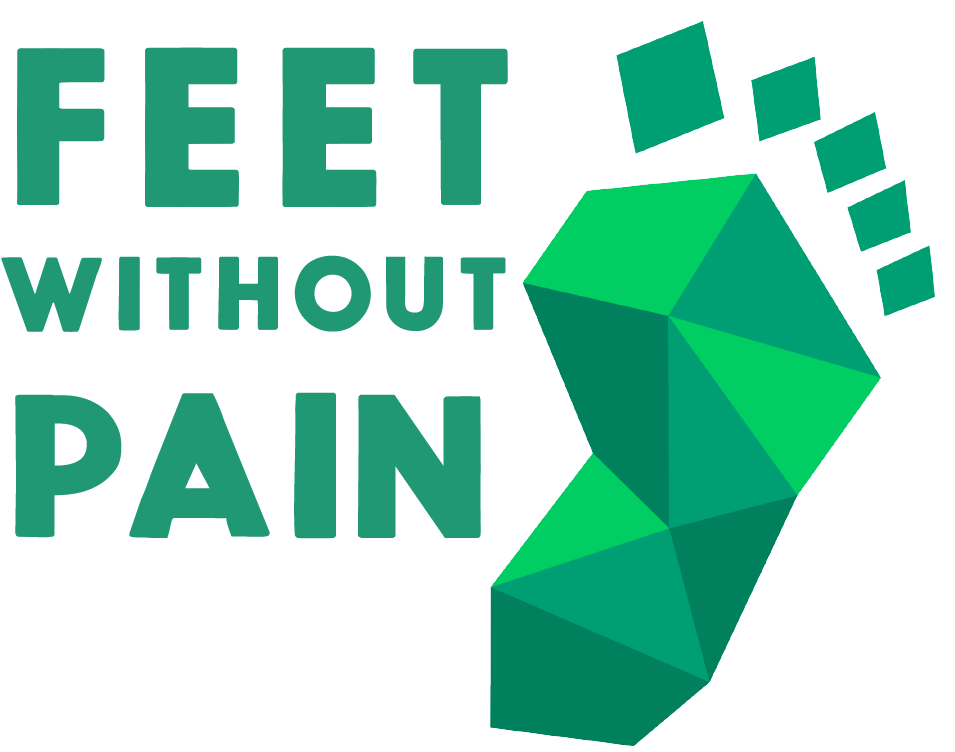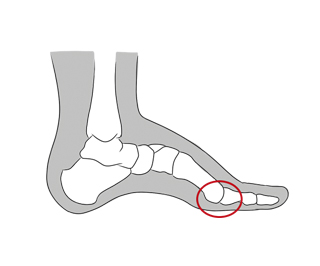All Metatarsals
The metatarsals are five long bones in the forefoot (area before the toes) and are responsible for stabilizing and supporting the foot in uneven terrain when walking. They are bones that articulate with the fingers (phalanges) and the tarsal bones (cuneiform and cuboidal), involved by the intrinsic musculature of the feet. Some possible diagnoses of pain in all metatarsals may be associated with cases of metatarsalgia, Morton’s Neuroma, hallux valgus (bunion), hallux rigidus, pes cavus, calluses, injuries, traumas, or stress fractures.
Pain in the metatarsals tends to affect women more often than men, mainly due to the prolonged use of high heels in everyday life. For treating this type of pain, it is crucial to be assessed by a foot specialist, as he will be able to correctly diagnose the cause of the pain and make appropriate recommendations for the case.
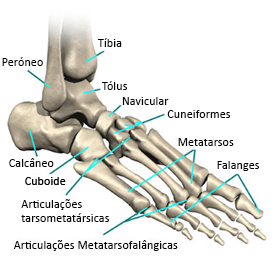
CAUSES
People exert, daily and incorrectly, significant pressure on some regions of the feet. For example, the use of inadequate and uncomfortable shoes for long periods, professions requiring the employee to stand up during long workdays, or even deformations and inflammation of some regions of the feet can be some of the possible explanations for pain in all metatarsals.
The causes of pain may be linked to several factors, from excessive loads in the region of the metatarsal bones to injuries and traumas. Being overweight can also contribute to increased pain in all metatarsals, as excess mass can overload and press, in an exaggerated way, the bones that are connected to the toes.
Inadequate shoes
Poor use of shoes is a fundamental factor for pain in the metatarsals. For example, women who wear high heels frequently tend to develop metatarsal pain and inflammation to a greater extent than men and for more extended periods. Because this type of footwear alters the body’s biomechanics, it throws the individual’s weight forward, leading to an increased load on the head of the metatarsals.
Shoes that put pressure on the foot or too tight laces can also contribute to pain. Wearing rigid shoes can also harm the metatarsals, as the foot will suffer a greater impact when walking, generating unnecessary friction in some regions.
Therefore, wearing comfortable sneakers and shoes during the day is vital, as they improve the distribution of pressure on the feet and can reduce pain in all metatarsals.
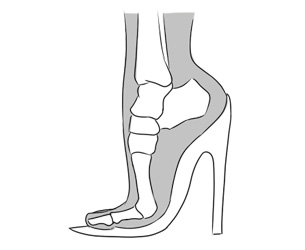
Overloads
The region where the metatarsals are located is susceptible to significant impacts when walking and running, especially with inappropriate shoes and sneakers. In addition, the prolonged performance of intense physical activities, or the practice of high-impact sports (with great use of jumps and sudden stops), requires significant effort from the body’s biomechanics and can accelerate the process of pain in the metatarsals or the development of stress fractures.
Excess weight can also contribute to a higher incidence of pain in the metatarsals due to increased pressure on the feet and the incidence of injuries and inflammation.
Trauma
Pain in the metatarsals may be related to involuntary trauma and injuries due to hitting hard objects (such as beds, sofas, or doors), falling objects (very susceptible to this type of incident), or even collisions in sports matches.
In cases like these and acute pain, follow-up with a specialized doctor is fundamental for appropriate treatment.
MAIN PATHOLOGIES RELATED TO PAIN IN THE METATARSALS
Metatarsalgia
It is an inflammation of the metatarsals and usually occurs when these bones are overloaded. It is related to the use of high heels and the practice of long walks or high-impact sports.
Morton’s neuroma
The thickening of a nerve passes between the metatarsals and usually occurs between the third and fourth metatarsals. Individuals with this pathology have the feeling that they are stepping on stones.
People with pes cavus have an accentuated plantar arch, contributing to increased metatarsal overload. This pathology may be linked to the genetics of individuals and must be treated with special insoles from childhood.
People with these types of deformities have greater finger stiffness when walking and put excessive pressure on the metatarsal head, contributing to calluses or inflammation.
Stress fracture of the metatarsals
This type of fracture occurs due to long periods of overload on the five metatarsals. It is common in high-impact and running sports.
Sesamoiditis
It is a type of inflammation that affects the sesamoid bones (small spherical bones near the joint between the first metatarsal and the phalanges). They are common in dancers.
Hallux valgus (bunion)
The bunion forms due to the “thumb” deviation toward the other toes and the first metatarsal contraction towards the foot’s inside. Most cases of hallux valgus are due to hereditary factors.
Freiberg disease
It is a disorder in the cartilage of the head of the second metatarsal and usually develops during adolescence. It generates well-localized swelling and pain.
Hallux Rigidus
It is a pathology that causes increased friction between the proximal phalanx and the first metatarsal. It is the most common type of arthrosis of the foot and causes increased stiffness in the big toe, making it more difficult to walk (due to pain from bone wear). Therefore, treatments should start early to avoid total loss of movement of the big toe and deformations.
PREVENTION AND TREATMENT
As seen earlier, the causes of pain in the metatarsals can come from several factors, from the formation of calluses to the development of a stress fracture. Therefore, the exact diagnosis can only be made by a foot specialist after an analysis of the affected region has been carried out. In some situations, the cause of pain will only be found after imaging tests.
Because of this, treatments for pain in all metatarsals may also vary from case to case. But, in general, some care can be taken to prevent and relieve pain, such as:
– Decrease the load and intensity of physical exercises;
– Lose weight to reduce mass overload in the bones of the foot;
– Putting on ice in affected areas for 15 or 20 minutes can relieve pain;
– There should be greater awareness regarding the use of high heels and tight shoes, as these are the main villains of pain in the metatarsals;
– Use of Feet Without Pain custom insoles and shoes.
FEET WITHOUT PAIN® CUSTOM SHOES AND INSOLES FOR PAIN IN ALL METATARSALS
Feet Without Pain custom-made insoles help redistribute pressure under the metatarsals, relieving overload in the region and resolving pain. An elevation is precisely positioned before the pain area to achieve this.
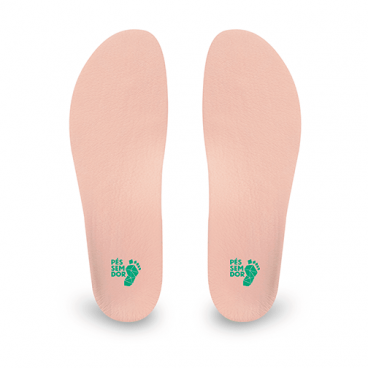
Custom shoes are made respecting the metatarsals’ width and circumference. As a result, we can achieve a perfect fit, avoiding pain caused by compression for those with wide feet and a lack of stability with a lot of friction when the shoe is too loose. In addition, custom-made shoes can have one of our 3D-printed soles, guaranteeing excellent shock absorption and support.
The custom insoles and shoes are made with 3D technology and millimetric digital precision after a free foot, ankle, and knee evaluation with our specialists at one of our branch offices. Check some of their benefits for your feet below:
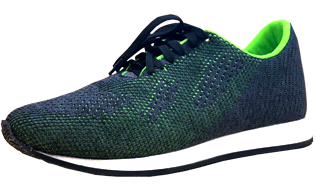
Unisex Sneakers Feet Without Pain | You can choose from over 20 men’s and women’s shoe models.
- Elimination or reduction of pain;
- Injury prevention;
- Increased comfort;
- Perfect fit;
- Standing longer without pain or discomfort;
- Prevention of pathologies progression;
- Improved impact absorption;
- Improved sports performance.
FREQUENTLY ASKED QUESTIONS
How to purchase your custom shoe or insole?
It’s fast and easy! Schedule a free evaluation of your feet with our specialists to buy your custom-made shoe.
Call, send a message to WhatsApp at 4003-8883, or visit: www.pessemdor.com.br/agendamento.
How does the evaluation work?
Upon arriving at a Feet Without Pain branch office, you will be received by a foot, ankle, and knee specialist, who will then fill out a registration form and ask some questions about your pain. Next, the assessment of the feet begins.
The specialist will perform an examination of your feet to understand your foot pains and complaints. Then, using the high-precision 3D scanner device, the specialist captures your feet’ measurements.
We are the only company with a 3D scanner for designing custom shoes. First, with the measurements of your feet, a mold is created using 3D printers, and after that, we start making your shoe.
How long does it take for the shoes and insoles to be ready?
Feet Without Pain produces custom-made shoes in up to 3 days; then, they are sent to your home free of charge!
Is the evaluation free?
Our assessment is completely free! We perform a complete analysis of your feet and legs, and you pay nothing for it!
Do we accept medical insurance?
We do not work with insurance because our assessment is completely free! But you can check if your plan somehow refunds you regarding the shoes!
EXTERNAL LINKS
1) All about metatarsalgia | Medical News Today
2) Fraturas dos metatarsos | Clínica e Cirurgia do Pé e Tornozelo
